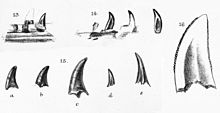Nuthetes destructor
|
Nuthetes Temporal range: Early Cretaceous, 143 Ma |
|
|---|---|
 |
|
| Portions of the holotype mandible and close up of a tooth | |
| Scientific classification | |
| Kingdom: | Animalia |
| Phylum: | Chordata |
| Clade: | Dinosauria |
| Order: | Saurischia |
| Suborder: | Theropoda |
| Family: | †Dromaeosauridae |
| Genus: |
†Nuthetes Owen, 1854 |
| Species: | †N. destructor |
| Binomial name | |
|
Nuthetes destructor Owen, 1854 |
|
| Synonyms | |
|
Megalosaurus destructor (Owen, 1854) |
|
Megalosaurus destructor (Owen, 1854)
Nuthetes is the name given to a dubious, possibly dromaeosaurid, genus of theropod dinosaur, known only from fossil teeth and jaw fragments found in rocks of the middle Berriasian (Early Cretaceous) age in the Cherty Freshwater Member of the Lulworth Formation in England. As a dromaeosaurid Nuthetes would have been a small predator, about two metres long.
The genus Nuthetes contains one species (the type species), Nuthetes destructor. N. destructor was named and described by Richard Owen in 1854. The generic name Nuthetes is derived from the Koine Greek nouthetes, a contraction of νουθέτητης (nouthetetes) meaning "one who admonishes" or "a monitor," in reference to the similarity of Nuthetes teeth to those of a modern monitor lizard. The specific name is Latin for "destroyer", a reference to "the adaptations of the teeth for piercing, cutting, and lacerating the prey" of a form he estimated to be equal in size to the present Bengal monitor.
The holotype, DORCM G 913, was collected by Charles Willcox, an amateur paleontologist living at Swanage, from the Feather Quarry near Durlston Bay in a marine deposition of Cherty Freshwater Member of the Lulworth Formation, dating from the middle Berriasian. It consists of an about three inch long left dentary fragment with nine teeth. The holotype was once thought to be lost but was rediscovered in the seventies in the Dorset County Museum. Later several other teeth and specimen BMNH 48207, another dentary fragment from a somewhat smaller individual, were referred to the species. Owen in 1878 also assumed some fossilised scutes, of a type for which he coined the name "granicones", belonged to Nuthetes but these were in 2002 shown to be limb or tail osteoderms of a turtle, possibly "Helochelydra" anglica or "H." bakewelli.
...
Wikipedia
